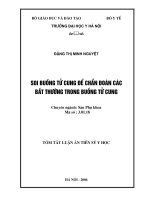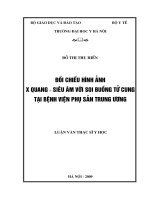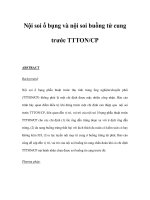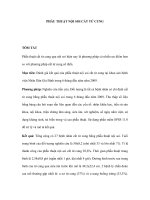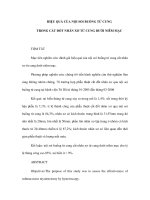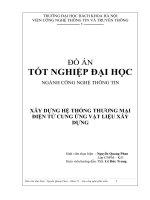Hệ thống nội soi Buồng tử cung mới cho bệnh nhân ngoại trú_Tiếng Pháp
Bạn đang xem bản rút gọn của tài liệu. Xem và tải ngay bản đầy đủ của tài liệu tại đây (3.08 MB, 24 trang )
<span class='text_page_counter'>(1)</span><div class='page_container' data-page=1>
New Hysteroscopic Systems
for Outpatient Use
Prudence V. Aquino-Aquino,MD
</div>
<span class='text_page_counter'>(2)</span><div class='page_container' data-page=2></div>
<span class='text_page_counter'>(3)</span><div class='page_container' data-page=3></div>
<span class='text_page_counter'>(4)</span><div class='page_container' data-page=4>
Mechanical Operating Systems
with tissue preservation
</div>
<span class='text_page_counter'>(5)</span><div class='page_container' data-page=5>
Mechanical Operating Systems with tissue preservation
<b>CAMPO Compact Hysteroscope TROPHYscopeđ </b>
<b>Special Features:</b>
ã
<b>Enables the primary approach to the uterine </b>
<b>cavity under visual control with an outer </b>
<b>diameter of only 2.9 mm</b>
•
<b>Innovative sheaths with sliding mechanism</b>
<b>- Sheaths are only used when required</b>
<b>- Atraumatic dilation of the cervix with the </b>
<b>telescope </b>
</div>
<span class='text_page_counter'>(6)</span><div class='page_container' data-page=6>
Hysteroscopes diameters
:
2.9mm
3.7mm
4.4mm
No cervical dilation is
required so no general
anaesthesia/analgesia
</div>
<span class='text_page_counter'>(7)</span><div class='page_container' data-page=7>
<b>PAA 2016</b>
Mechanical Operating Systems with tissue preservation
<b>CAMPO Compact Hysteroscope TROPHYscope® </b>
</div>
<span class='text_page_counter'>(8)</span><div class='page_container' data-page=8>
<b>Indications:</b>
<b>PAA 2016</b>
</div>
<span class='text_page_counter'>(9)</span><div class='page_container' data-page=9></div>
<span class='text_page_counter'>(10)</span><div class='page_container' data-page=10>
Insert video of challenging cases
</div>
<span class='text_page_counter'>(11)</span><div class='page_container' data-page=11>
<b>PAA 2016</b>
<b>Eur J Obstet Gynecol Reprod Biol. 2008 Aug;139(2):210-4. doi: 10.1016/j.ejogrb.2007.11.008. Epub 2008 Jan 14.</b>
<b>Outpatient operative polypectomy using a 5 mm-hysteroscope without anaesthesia and/or analgesia: advantages and </b>
<b>limits.</b>
<b>Litta P1, Cosmi E, Saccardi C, Esposito C, Rui R, Ambrosini G.</b>
<b>OBJECTIVE:</b>
<b>To assess the predictors of office-based operative hysteroscopic polypectomy using a 5.2mm continuous flow office </b>
<b>hysteroscope without anaesthesia and/or analgesia for the treatment of endometrial and/or isthmic polyps and to define </b>
<b>procedure limits.</b>
<b>STUDY DESIGN:</b>
<b>=Women with hysteroscopic diagnosis of endometrial or isthmic polyps were offered to proceed in the same session with </b>
<b>operative hysteroscopy after 15 min without anaesthesia and/or analgesia. </b>
<b>=All procedures were performed using a 5.2 mm continuous flow office hysteroscope. </b>
<b>=Patient procedure compliance was assessed by means of a visual analogue scale (VAS) using a rating scale with 11 </b>
<b>categories. </b>
<b>= A VAS < or = 4 was considered as patient procedure compliance. </b>
<b>Regression analysis was performed to correlate the following variables: time required, size and number of polyps with </b>
<b>VAS. A ROC analysis was performed to assess the cut-off of the strongest predictors. The influence of previous vaginal </b>
<b>delivery and menopausal status was correlated with the VAS.</b>
<b>RESULTS:</b>
<b>217 women underwent the office-based hysteroscopic procedure and 253 polyps were removed, </b>
<b>=170 were endometrial and 83 isthmic polyps. 181 women with single polyps and 36 women presented multiple polyps. </b>
<b>=The size of polyps ranged from 0.5 to 5 cm. </b>
<b>=Median time of the procedure was 10 min (range 3-30 min). </b>
<b>Regression analysis showed a statistical significative correlation between VAS and size of polyps and between VAS and </b>
<b>operating time independent to the number of polyps. Using the ROC analysis a VAS < or = 4 was obtained when polyps </b>
<b>were < or = 2 cm and/or time of the procedure lasted < or = 15 min. Menopausal status and previous vaginal deliveries were </b>
<b>not significantly correlated to the VAS.</b>
<b>CONCLUSIONS:</b>
<b>Office-based hysteroscopic polypectomy is a safe and feasible procedure and should be addressed in patients with </b>
<b>endometrial or isthmic polyps < or = 2 cm in diameter, and the procedure limits in terms of patient procedure compliance </b>
<b>are size of polyps and operating time, independent from menopausal status and previous vaginal delivery.</b>
<b>PMID: 18248873 DOI: 10.1016/j.ejogrb.2007.11.008</b>
<b>CONCLUSIONS:</b>
<b>=Office-based hysteroscopic polypectomy is a safe and feasible procedure and should be addressed </b>
<b>in patients with endometrial or isthmic polyps < or = 2 cm in diameter,</b>
<b>=Predictors of success of the procedure:</b>
<b>1) size of polyps and operating time, </b>
</div>
<span class='text_page_counter'>(12)</span><div class='page_container' data-page=12>
J Am Assoc Gynecol Laparosc. 2004 Feb;11(1):59-61.
Operative office hysteroscopy without anesthesia: analysis of 4863 cases performed with
mechanical instruments.
Bettocchi S1, Ceci O, Nappi L, Di Venere R, Masciopinto V, Pansini V, Pinto L, Santoro A,
Cormio G.
( )
Author information
Abstract
STUDY OBJECTIVE:
To evaluate the efficacy of, and patients' satisfaction with, office hysteroscopic treatment of
benign intrauterine pathologies using 5F hysteroscopic instruments.
DESIGN:
Observational clinical study (Canadian Task Force classification II).
SETTING:
University center.
PATIENTS:
Four thousand eight hundred sixty-three (4863) women.
INTERVENTION:
Office hysteroscopy without analgesia or anesthesia.
MEASUREMENTS AND MAIN RESULTS:
We used 5F mechanical instruments (scissors, grasping forceps) to treat cervical and
endometrial polyps ranging between 0.2 and 3.7 cm, as well as intrauterine adhesions and
anatomic impediments. From 71.9% to 93.5% of women underwent the procedure without
discomfort for all pathologies treated except endometrial polyps larger than the internal
cervical os, for which 63.6% experienced low or moderate pain. At 3-month follow-up,
pathology persisted in 364 patients (5.6%).
CONCLUSION:
Simple instruments enable us to perform many operative procedures in an office setting with
excellent patient satisfaction, provided that the indications are correct.
PMID: 15104833
[PubMed - indexed for MEDLINE]
<b>CONCLUSION:</b>
<b>Simple instruments enable us to perform many </b>
<b>operative procedures in an office setting with excellent </b>
<b>patient satisfaction, provided that the indications are </b>
<b>correct.</b>
<b>Findings:</b>
<b>5F mechanical instruments (scissors, grasping forceps) to treat cervical and </b>
<b>endometrial polyps ranging between 0.2 and 3.7 cm, as well as intrauterine </b>
<b>adhesions and anatomic impediments. </b>
<b>=71.9% to 93.5% of women underwent the procedure without discomfort for all </b>
<b>pathologies treated except endometrial polyps larger than the internal cervical </b>
<b>os, </b>
<b>=63.6% experienced low or moderate pain. </b>
</div>
<span class='text_page_counter'>(13)</span><div class='page_container' data-page=13>
SLMC QC experience
</div>
<span class='text_page_counter'>(14)</span><div class='page_container' data-page=14>
<b>PAA 2016</b>
</div>
<span class='text_page_counter'>(15)</span><div class='page_container' data-page=15>
<b>PAA 201</b>
<b>=Innovative and effective device</b>
<b>=Proposed and it may become in the near future a </b>
<b>valid alternative to the traditional transcervical</b>
<b>resectoscopic myomectomy.</b>
<b>Emanuel and Wamsteker, 2005 </b>
</div>
<span class='text_page_counter'>(16)</span><div class='page_container' data-page=16>
<b>PAA 2016</b>
<b>Continous flow of fluids + suction of fluids with shaved tissues</b>
<b>Problems that are addressed:</b>
<b>fluid overload, uterine perforation due to uni/bipolar currents and lack of visualisation due to specimens</b>
</div>
<span class='text_page_counter'>(17)</span><div class='page_container' data-page=17></div>
<span class='text_page_counter'>(18)</span><div class='page_container' data-page=18>
Direct Extraction of resected tissues through the
suction channel - Operating Sheath OD 8mm(24 Fr)
</div>
<span class='text_page_counter'>(19)</span><div class='page_container' data-page=19></div>
<span class='text_page_counter'>(20)</span><div class='page_container' data-page=20>
<b>PAA 2016</b>
<b>Conclusion</b>
<b>This new technique: easier to perform</b>
<b>Fewer fluid over-load</b>
</div>
<span class='text_page_counter'>(21)</span><div class='page_container' data-page=21>
<b>PAA 2016</b>
<b>Review of the complications after hysterosocpic myoemctomy </b>
<b>Interval between uterine operation infringing on the myometrium </b>
<b>and attempts for pregnancy </b>
<b>= should not be less than one year from the date of uterine surgery </b>
<b>(Valle and Buggish, 2007).</b>
<b>=caesarean section should be preferred when-ever you are dealing </b>
<b>with fibroids with intramural development </b>
<b>(Keltz et al., 1998; Cravello et al., 2004), </b>
</div>
<span class='text_page_counter'>(22)</span><div class='page_container' data-page=22>
<b>PAA 2016</b>
<b>Post-operative IUA </b>
<b>Incidence of post-operative IUAs </b>
<b>=the major long- term complication of hysterosocpic myomectomy </b>
<b>ranging from 1 to 13% (Wamstecker et al., 1993; Hallez, 1995; Giatras et al., </b>
<b>1999). </b>
<b>To minimize the risk of post-operative IUA:</b>
<b>1) avoid forced cervical manipulation, and trauma of healthy </b>
<b>endometrium and myometrium surrounding the fibroid;</b>
<b>2) it is also advisable to reduce the usage of electrosurgery especially </b>
<b>during the removal of fibroids with extensive intramural involvement </b>
<b>(Mazzon, 1995) and multiple fibroids on opposing endometrial surfaces </b>
<b>(Indman, 2006). </b>
</div>
<span class='text_page_counter'>(23)</span><div class='page_container' data-page=23></div>
<span class='text_page_counter'>(24)</span><div class='page_container' data-page=24>
<b>PAA 2016</b>
</div>
<!--links-->
